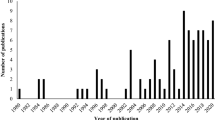Abstract
Considering the decay risk of wood structures in temperate regions and the need to implement environmentally sound and healthy safe integrated pest management strategies, the main objective of this research was to detect xylophagous insects (especially termites) at an early stage as well as to relate the wood conditions in buildings (moisture content and temperature) to the infestation risk of the main wood-rotting fungi. To do this, an advanced sensor was developed. It sends a wireless alarm with the indication of termite activity inside the wood or with the warning signal that the conditions in the wood make it vulnerable to fungal settlement. After investigating the main detection parameters and testing different prototypes under varying laboratory conditions, a final sensor was developed for use in real conditions. Furthermore, a wireless network of these biodegradation sensors was developed and installed in three representative buildings for their automatic monitoring, forming an integral alarm system for wood degradation activity supported by an advanced remote sensing management.








Similar content being viewed by others
References
Ahmed BM, French JRJ (2008a) Laboratory bioassay on termite wood consumption using two different substrates. Sociobiology 51(1):141–150
Ahmed BM, French JRJ (2008b) An overview of termite control methods in Australia and their link to aspects of termite biology and ecology. Pak Entomol 30(2):1–18
Creffield JW (1996) Wood destroying insects. Wood borers and termites. CSIRO Publications, Melbourne
Cymorek S (1984) Schadinsekten in Kunstwerken und Antiquitäten aus Holz in Europa. Holzschutz–Forschung und Praxis. Symposium 1982:37–56. DRW-Verlag Weinbrenner KG. Leinfelden-Echterdingen
EN 13183-1 (2002) Moisture content of a piece of sawn timber—Part 1: determination by oven dry method
EN 117 (2007) Wood preservatives–Determination of toxic values against Reticulitermes species (European termites) (laboratory method)
French JRJ, Ahmed BM, Thorpe J (2010) Deciding the age of subterranean termite damage in buildings. In: 41st annual IRG conference. International Research Group of Wood Protection. 09-13.05.2010. Biarritz
Grosser D (1985) Pflanzliche und tierische Bau- und Werkholzschädlinge. DRW-Verlag Weinbrenner KG, Leinfelden-Echterdingen
Gutiérrez Oliva A, López de Roma A, Navarrete Varela A (1984) Wood in construction (in Spanish). Informes de la Construcción 35(358):5–28. DOC 414 A. Santiago
Krishna H, Weesner F (1970) Biology of termites, vol II. Academic Press, New York
Lewis V (2001) Alternatives to POPs for managing termites. UNEP/WHO workshop on sustainable approaches for pest and vector management and opportunities for collaboration in replacing POPs pesticides. Panama City 12-15.02.2001. Proceedings, pp 166–170
Moreno MT, Mora D, Gajú M (2009) 50 questions on termites and their pest control (in Spanish). ISS Facility Services. DL OU51-2009. Madrid
Przewloka S, Ahmed B, Hann J, Vinden P, Blackwell P, Plews P (2007) Biodeterioration of treated Pinus radiata timber by Australian decay fungi and the termite Coptotermes acinaciformis in laboratory bioassays and field conditions. Holzforschung 61(2):207–213
Simpson WT (1998) Equilibrium Moisture Content of Wood in Outdoor Locations in the United States and Worldwide. U.S. Department of Agriculture, Forest Service, Forest Products Laboratory. Res. Note FPL-RN-0268. Madison, WI
UNEP (2000) Finding alternatives to persistent organic pollutants (POPs) for termite management. UNEP/FAO/Global IPM Facility Expert Group on Termite Biology and Management, Nairobi
Unger A, Schniewind AP, Unger W (2001) Conservation of Wood Artifacts. Springer, Heidelberg
Weidner H (1970) Isoptera (Termiten). In: Handbuch der Zoologie. eine Naturgeschichte der Stämme des Tierreiches. IV. Band. Verlag Walter De Gruyter & Co. Berlin
Weiss B, Wagenführ A, Kruse K (2000) Beschreibung und Bestimmung von Bauholzpilzen. DRW-Verlag Weinbrenner KG, Leinfelden-Echterdingen
Acknowledgments
The research was funded by the Ministry of Industry, Science and Technology of Spain under the PROFIT programme (2006–2009). The research results were awarded with the SCHWEIGHOFER Innovation Price 2009.
Author information
Authors and Affiliations
Corresponding author
Rights and permissions
About this article
Cite this article
Oliver-Villanueva, J.V., Abián-Pérez, M.A. Advanced wireless sensors for termite detection in wood constructions. Wood Sci Technol 47, 269–280 (2013). https://doi.org/10.1007/s00226-012-0485-8
Received:
Published:
Issue Date:
DOI: https://doi.org/10.1007/s00226-012-0485-8




